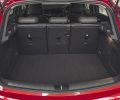
MARKET AND MODEL
- New Astra available to order now, with first cars arriving in showrooms this November
- CO2 emissions and fuel consumption reduced by up to 21% versus outgoing model
- Astra will make its world premiere at IAA Frankfurt in September
With first cars arriving in showrooms this November, Vauxhall’s new Astra is on sale now.
One of the UK’s top-selling and best-loved cars, Astra is a household name for British car buyers with over three million sold in the UK over the last 40 years, including over 30,000 in 2018. More than 25 per cent of British motorists have either owned or driven an Astra, so reaction to a model with significant revisions will always be felt across the market.
The 2019 Astra sets the standard for efficiency and low emissions with an all-new range of petrol and diesel powertrains. Building on the wide success of the outgoing model, customers will benefit from reduced CO2 and fuel consumption, as well as a series of class-leading technology and equipment.
Meticulous development in the wind tunnel also made a significant contribution to the reductions in fuel consumption and CO2 emissions of up to 21 per cent versus the outgoing model.
With a drag coefficient figure of just 0.26, the Astra leads the class for aerodynamics. And at 0.25 Cd, the Astra Sports Tourer is also best-in-class, too. These aero-benchmarks have been achieved through numerous measures, including an engine compartment cover, deflector-shaped rear axle control arms and a full-face shutter.
The upper and lower portions of the new Astra’s radiator grille automatically open and close independently of one another, further improving the frontal airflow. The underbody optimisation improves the drag coefficient by reducing turbulence.
The Astra’s chassis has undergone a number of improvements, too. New dampers provide greater bump control, even on poor surfaces, while the steering has received a new calibration, resulting in improved handling at higher speeds.
POWERTRAINS
- New range of petrol and diesel engines and new nine-speed automatic gearbox
- CO2 emissions and fuel consumption reduced by up to 21% versus outgoing model
- Seven-speed continuously variable transmission also available
The new turbocharged petrol and diesel engines, which are as economical as they are lively, are primarily responsible for a marked improvement in Astra’s efficiency. The low consumption and CO2 figures are also thanks to the Astra’s six-speed manual gearboxes, the seven-speed continuously variable transmission (CVT) and – for the first time at Vauxhall – a new nine-speed automatic.
The compact, three-cylinder, turbo petrol units are available with 1.2 and 1.4-litre displacements. With the new 1.2-litre petrol engine, the Astra achieves a 6kg weight loss versus the outgoing 1.4T (150PS) engine. With power outputs extending from 110PS to 145PS and maximum torque from 195Nm to 236Nm, they achieve an excellent balance between performance and efficiency.
The Astra 1.2-litre is combined with a smooth-shifting six-speed manual gearbox while the Astra 1.4-litre is available exclusively with a new seven-speed CVT. With the CVT, Astra drivers can enjoy the convenience of automatic gear changing or select gears themselves via the shift lever.
Integration of the water-cooled exhaust manifold in the cylinder head contributes to quick engine warm-up, which lowers emissions after a cold start.
Typical for Vauxhall is the excellent transient throttle response of the petrol engines – at 1,500 rpm.
Diesel Engines
The Astra’s 1.5-litre, three-cylinder diesel engines offer 105PS and 122PS, as well as 260Nm to 300Nm of torque. The common rail fuel injection system operates at up to 2,000 bar.
As an alternative to the standard six-speed manual gearbox, the most powerful diesel is available with the option of a smooth-shifting new nine-speed automatic transmission, which is makes its debut in the new Astra.
The new diesel engines feature an electrically-activated turbocharger with variable geometry turbine vanes and, like their petrol counterparts, a balance shaft in the block for additional refinement. Likewise, the exhaust manifold is also integrated in the cylinder head.
Optimum exhaust after-treatment of the Astra 1.5 diesel is delivered by the emissions reduction system consisting of a passive oxidation catalyst, AdBlue injector, SCR catalyst and Diesel Particulate Filter.
| Engine & Transmission | Body style |
Combined Low* mpg (l/100km) |
Combined High* mpg (l/100km) |
CO2* g/km |
| Petrol | ||||
| 1.2 (110PS) Turbo 6 speed manual | Hatch | 51.4 (5.5) | 54.3 (5.2) | 99 |
| 1.2 (130PS) Turbo 6 speed manual | Hatch | 51.4 (5.5) | 54.3 (5.2) | 99 |
| 1.2 (145PS) Turbo 6 speed manual | Hatch | 51.4 (5.5) | 54.3 (5.2) | 99 |
| 1.4 (145PS) Turbo stepless automatic | Hatch | 46.3 (6.1) | 48.7 (5.8) | 112 |
| Diesel | ||||
| 1.5 (105PS) Turbo D 6 speed manual | Hatch | 60.1 (4.7) | 64.2 (4.4) | 95 |
| 1.5 (122PS) Turbo D 6 speed manual | Hatch | 58.9 (4.8) | 62.8 (4.5) | 95 |
| 1.5 (122PS) Turbo D 9 speed automatic | Hatch | 51.4 (5.5) | 54.3 (5.2) | 120 |
| Petrol | ||||
| 1.2 (110PS) Turbo 6 speed manual | Sports Tourer | 50.4 (5.6) | 53.3 (5.3) | 102 |
| 1.2 (130PS) Turbo 6 speed manual | Sports Tourer | 50.4 (5.6) | 53.3 (5.3) | 102 |
| 1.2 (145PS) Turbo 6 speed manual | Sports Tourer | 50.4 (5.6) | 53.3 (5.3) | 102 |
| 1.4 (145PS) Turbo stepless automatic | Sports Tourer | 45.6 (6.2) | 47.9 (5.9) | 112 |
| Diesel | ||||
| 1.5 (105PS) Turbo D 6 speed manual | Sports Tourer | 58.9 (4.8) | 62.8 (4.5) | 94 |
| 1.5 (122PS) Turbo D 6 speed manual | Sports Tourer | 58.9 (4.8) | 62.8 (4.5) | 94 |
*Preliminary data
ADVANCED DRIVER ASSISTANCE SYSTEMS AND CONNECTIVITY
- Class-leading technology provides safety and connectivity
- Available with smaller and more powerful digital front camera
The new Astra is available with a new digital front camera, which is both smaller and more powerful than before thanks to a faster processor. It now not only recognises vehicles, but also pedestrians, greatly improving safety. Furthermore, thanks to the high-resolution camera, traffic sign recognition can now process even more traffic signs and show them as symbols on the display.
The digital rear view camera, available on selected models, is also more powerful, and works in conjunction with the new Multimedia Navi Pro infotainment system. The view of the traffic behind the vehicle on the monitor is more distinct and precise, while the contrasts are more visible in the dark.
Astra customers will enjoy high levels of connectivity with the smarter, faster and more intuitive Multimedia Radio, Multimedia Navi and Multimedia Navi Pro systems. All systems are compatible with Apple CarPlay and Android Auto without the need for the customer paying expensive subscriptions. The top-of-the-line Multimedia Navi Pro – already featured in the Vauxhall Insignia flagship – has an eight-inch colour touchscreen and can also be operated by voice control. Connected navigation services with real-time traffic information and online map updates make the journey more relaxed, while the navigation display itself appears with redesigned symbols in a fresher, more modern look. The same applies to the instrument cluster, which features a new digital speedometer.
Available as an option, is the E-Call emergency call function. If needed, help is just seconds away by pressing the red button. If the seatbelt tensioners or airbags are deployed, the system automatically makes an emergency call.
Comfort is a top priority in the new Vauxhall. A practical feature when travelling, compatible smartphones can now also be charged inductively via wireless charging on selected models. All the driver needs to do is place their smartphone into an opening in the centre console.
The high-end Bose sound system, featured on selected models, transforms the new Astra into a concert hall. Seven loudspeakers, including a RichBass subwoofer under the boot, ensure optimum listening pleasure. The driver and passengers are surrounded by a rich sound, regardless of where they are in the vehicle. In addition, up to eight different sound profiles can be stored via the digital amplifier.
Last but not least, the new Astra introduces a heated windscreen on selected models, making driving in the winter safer and more comfortable. Thin, almost invisible wires in the windscreen ensure that Astra drivers always have a clear view of the road on frosty days.
AERODYNAMICS
- Aero-benchmark: most aerodynamic compact car on the market
- Full-face shutter and optimised underbody are key to aerodynamic design
With an impressive drag coefficient of 0.26, the new Vauxhall Astra is leads the class for aerodynamics.
The aerodynamic design of the Astra plays a vital role in the challenge to reduce CO2 emissions. By reducing drag, and therefore also fuel consumption and emissions, Vauxhall is helping customers and fleet managers to achieve significant cost savings while promoting efficient driving. In total, the aerodynamic developments of the new Astra save 4.5g of CO2 per kilometre (in accordance with the WLTP cycle).
Key to the aerodynamic design of the new Astra is the active full-face shutter. The upper and lower portions of the grille can be opened and closed, even independently from each other, resulting in highly efficient driving under a variety of real-life conditions. For example, a ten per cent cut in drag results in a fuel consumption reduction of around two per cent in the New European Driving Cycle (NEDC), or up to five per cent when driving at 70mph. The reduction in drag achieved by the full-face active shutter alone lowers CO2 emissions of the new Astra by up to 2.0g/km.
The full-face shutter also delivers thermal advantages by delaying cooling down after switching off the engine, or by accelerating the engine warm-up after a cold start. This is especially important in winter, providing significant benefits in fuel consumption and comfort by heating the interior of the car.
In the pursuit for a truly aerodynamic design, Vauxhall engineers focused much of their attention around the underbody, wheels and wheel arches. The underbody airflow-improvements include a cover under the engine and transmission, panels at the front of the floor and an enlarged fuel tank heatshield that doubles as an air deflector. The ride-height has been lowered by up to 10mm, depending on trim level, and aerodynamically shaped control arms have been added to the rear axle.
The new Vauxhall Astra will make its debut at the IAA Frankfurt International Motor Show next month.
ASTRA HERITAGE
Vauxhall’s Astra has been a UK best-seller with three million sold over the last 40 years. Here we take a look back over the Astra’s rich history spanning seven generations.
Astra Mk 1
The 1979 Astra Mk 1 represented a complete transformation for the brand, and also set new standards of comfort, handling and refinement for its class.
The newcomer was the first front-wheel-drive compact family car from Vauxhall and it rose head-on to the challenge of the VW Golf, a car that had won over pundits across Europe for its quality, front-wheel-drive handling and packaging, but which would finally meet its nemesis at the hands of Vauxhall’s new offering.
The Mk 1 was neatly styled and exceptionally well made, offering comfort and build quality never before seen in a Vauxhall of this size. It was also offered in a myriad of body styles, including three and five-door hatchbacks, a four-door saloon, three and five-door estates and a panel van.
A new range of OHC engines and a 1.6-litre diesel (another first for Vauxhall in this area of the market) added further to the car’s appeal, especially in the key fleet market. The Mk 1 also saw the birth of the first Astra GTE, a performance icon that would become one of the best-known hot hatches of the 1980s. Over half a million MK 1 Astras were sold.
Astra Mk 2
By the mid-1980s, aerodynamic efficiency was very much in vogue, and the Astra Mk 2 certainly didn’t disappoint. It carried over the platform and powertrains from the first generation car, but the design team had been set the task of achieving a drag co-efficient of less than 0.30 – a figure more akin to a sports car than to a family hatchback.
Launched in 1984, the Mk 2 was quite a surprise, featuring such innovation as flush-fitting guttering and windows, a wraparound bumper and a curvaceous, wind cheating front end that successfully combined handsome looks with the desired aerodynamic efficiency.
The result of the designers’ efforts was a car that, even today, doesn’t look outdated in modern traffic, and which quite deservedly won the 1985 European Car of the Year award.
Again, the number of engines and trim levels were vast, as were the different body styles – although this time the four-door saloon was sold as a standalone model named Belmont, and there was also a two-door convertible styled by Bertone.
The GTE was once again the iconic figurehead of the range, especially from 1990 when it gained a new 16v engine, developing 150bhp. Over 600,000 Astra Mk 2s were sold in a seven-year period.
Astra Mk 3
Introduced in 1991, the Astra Mk 3 built further on the success of the Mk2 by adopting a similarly slippery body shape, albeit taller, wider and longer than the car it replaced in order to increase passenger space and comfort.
The newcomer was 34 per cent stiffer than the outgoing car, which made for tidy, well-composed handling, while interior quality and trim levels were also improved in what had become a particularly competitive area of the market, especially among fleet customers.
The car was launched at the 1991 Frankfurt Motor Show, where it became the first Opel to adopt a name from Vauxhall – GM’s continental European arm deciding to drop the established Kadett moniker after 55 years in favour of that used by the British.
As one of the safest and best-equipped cars in its segment, the Mk 3 was hugely popular with British buyers and the Mk 3 was never out of the top 10 sellers’ charts throughout its life – with total UK sales of over 600,000 when it was finally withdrawn in 1998.
Astra Mk 4
Some of the greatest innovations in motoring aren’t visible to the naked eye, and in the case of the Astra Mk 4 its fully-galvanised bodyshell may not have had the showroom appeal of stacks of standard equipment, but it did ensure that, even today, a Mk 4 Astra with any signs of rust is a rarely-witnessed sight.
This longevity was part of a programme instigated at the car’s design stage to deliver a level of quality, integrity and solidity that buyers had come to expect from more upmarket brands, yet deliver them to Vauxhall’s target, mainstream customer – a message that went down especially well with fleet customers, who lapped up Mk 4 Astras.
The Mk 4 Astra was a tempting showroom proposition, with excellent equipment levels, well-sorted dynamics and class-leading performance from its most popular engine choices. Of particular interest were the Bertone-styled (and built) coupe and convertible models introduced in 2000, the latter of which had a button on the keyfob with which you could remotely raise and lower the roof.
The Mk 4 was also the first Astra (and, indeed, the first compact hatchback in the UK) to comply with the Euro 4 emissions legislation that has become the norm today – all 1.7 CDTi models from 2002 onwards met the new criteria.
Astra Mk 5
The Mk 5 in 2004 brought with it a new era of stylish design and driving dynamics, moving the Astra up a gear in terms of its showroom appeal and winning universal praise at launch for its handsome good looks.
Building on the car’s visual attributes were a new range of engines including 1.9-litre CDTi diesels, which offered all the performance of a high-powered petrol engine with none of the associated running costs.
Indeed, the 1.9 CDTi 150 version of the Astra has exactly the same power output as the Astra Mk 2 GTE 16v – a car renowned for its phenomenal performance. Following on from the five-door hatch and estate models at launch, Vauxhall introduced the three-door ‘Sport Hatch’ in 2005, combining the appeal of a coupe and a three-door hatchback in one body style, and introducing such options as the new ‘Panoramic’ windscreen, with a glass area that cut back into the roof to give incredible airiness and visibility.
A panel van joined the line-up in 2006, along with the Astra TwinTop – a hard-roofed coupe that could be turned into an open top at the push of a button.
Astra Mk 6
Launched at the 2009 Frankfurt Motor Show, Vauxhall’s outgoing Astra raised the bar for compact cars sold in the UK, with a combination of stylish design, class-leading dynamics, ultra-efficient powertrains and upscale quality.
With its strong, cab-forward silhouette, steeply raked windscreen and sloping rear roofline, the Astra MK 6 made ingenious use of many of the design features found in the Insignia, but in a fresh and innovative way.
Also like the Insignia, it spent over 600 hours in the wind tunnel, benefiting performance, economy and overall refinement. Echoing the flowing forms of its bodywork, the MK 6 Astra’s interior marked a major shift towards premium design and quality in the compact sector.
It employed the recurring wing and blade motifs that were first introduced in the Insignia but used in a fresh and innovative way.
Continuing Vauxhall’s trend for innovation, its engineers combined the size, weight and efficiency benefits of a compound crank rear axle with a cleverly positioned Watt’s link, which helped support lateral forces during cornering. Innovative technology included Advanced Forward Lighting, ergonomic driver’s seat, FlexFloor boot storage and Flex-Fix integrated bike carrier.
Astra Mk 7
Debuting at the 2015 Frankfurt Motor Show, the Astra Mk 7 was based on an all-new lightweight vehicle architecture with a new design, powertrains and technology.
Depending on the model and trim level it was up to 200kg lighter than its predecessor. The completely new vehicle architecture played a major role in the weight reduction. Every component was checked for compact design and lightweight materials. The body shell weight alone was reduced by 20 per cent from 357kg to 280kg.
Additional, chassis-related measures resulted in a further 50kg weight loss. These included high-strength and ultra-high-strength low-weight steels, compact subframes as well as weight reductions to the front and rear axle.
The powertrain portfolio featured petrol and diesel units ranging from 100PS to 200PS, including an all-new 1.4-litre (150PS) ECOTEC Direct Injection Turbo and the recently-launched 1.6-litre CDTi Whisper Diesel.
Astra Mk 7 was also the first Vauxhall to feature OnStar, the ground-breaking connectivity technology that included high-speed 4G LTE mobile network, emergency response notification and stolen vehicle recovery alert. Astra Mk 7 was also one of the first vehicles from a mainstream manufacturer to get Apple CarPlay and Android Auto, available through a new version of the IntelliLink infotainment system.













